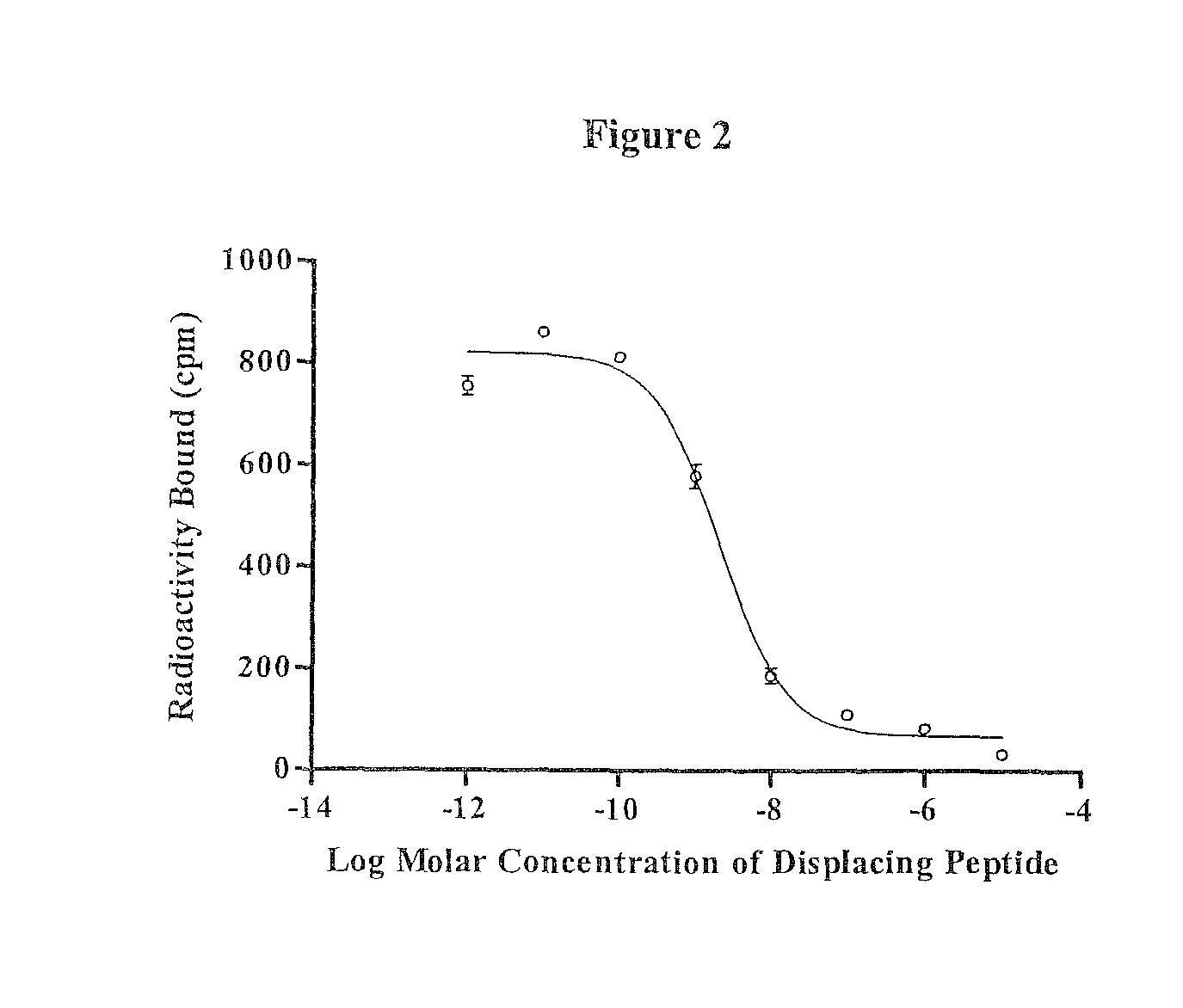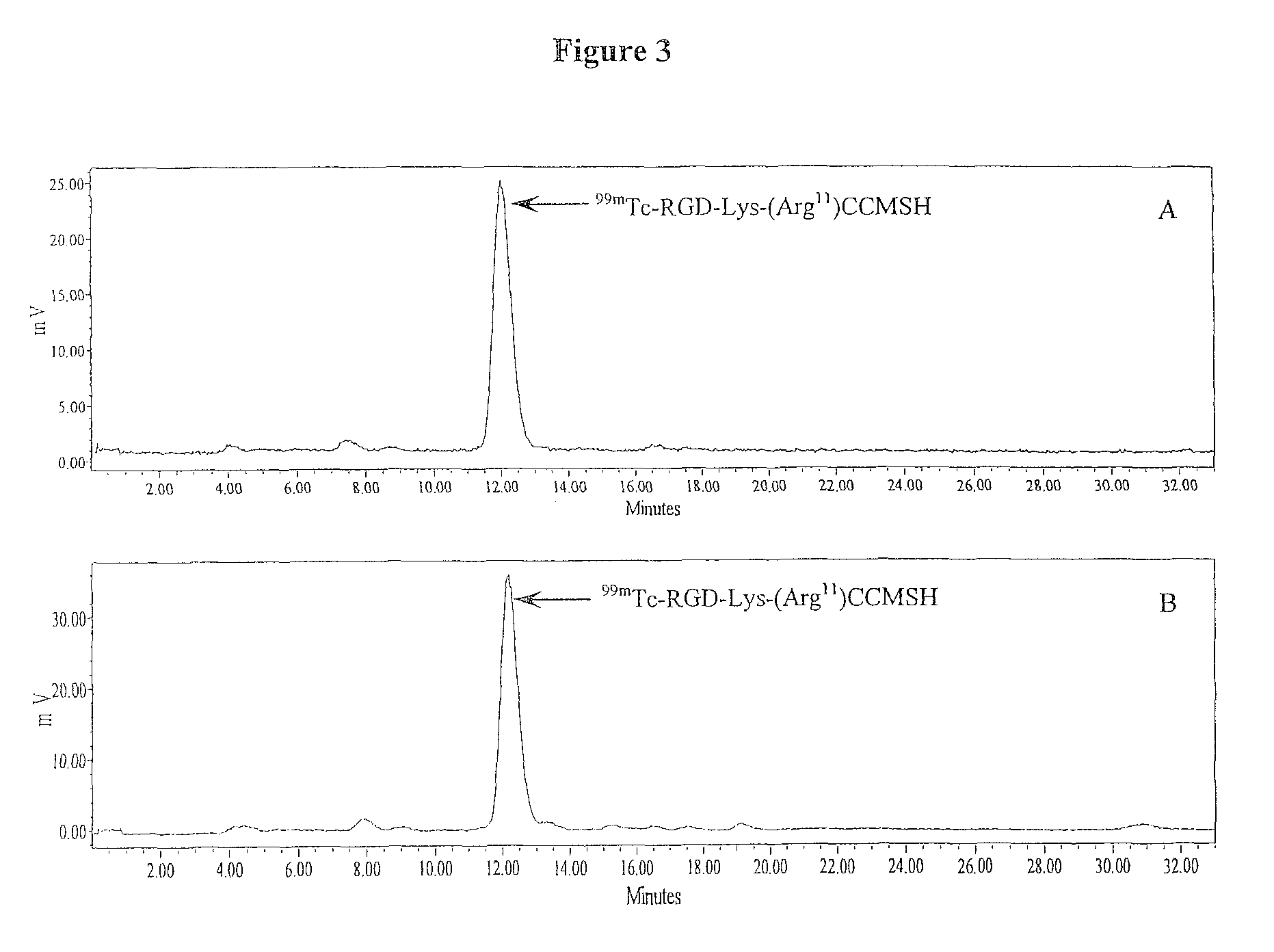Arg-Gly-Asp-conjugated alpha-melanocyte stimulating hormone hybrid peptide for use in diagnosing and treating melanoma, including metastatic melanoma and methods related to same
a technology of arg-glyasp and melanoma, which is applied in the direction of peptide/protein ingredients, lyase, therapy, etc., can solve the problems of no curative treatment exists for metastatic melanoma, etc., and achieves favorable pharmacokinetics and reduces the renal uptake of compounds
- Summary
- Abstract
- Description
- Claims
- Application Information
AI Technical Summary
Benefits of technology
Problems solved by technology
Method used
Image
Examples
example 1a
Peptide Synthesis
[0129]Intermediate scaffold of H2N-Arg(Pbf)-Gly-Asp(OtBu)-dTyr(tBu)-Asp(O-2-phenylisopropyl)-Lys(Boc)-Cys(Trt)-Cys(Trt)-Glu(OtBu)-His(Trt)-DPhe-Arg(Pbf)-Trp(Boc)-Cys(Trt)-Arg(Pbf)-Pro-Val was synthesized on Sieber amide resin using standard 9-fluorenylmethyloxycarbonyl (Fmoc) chemistry by an Advanced ChemTech multiple-peptide synthesizer (Louisville, Ky.). A small aliquot of the scaffold material was cleaved and characterized by liquid chromatography-mass spectroscopy (LC-MS). The protecting group of 2-phenylisopropyl was removed and the peptide was cleaved from the resin treating with a mixture of 2.5% of trifluoroacetic acid (TFA) and 5% of triisopropylsilane. After the precipitation with ice-cold ether and characterization by LC-MS, the protected peptide was dissolved in H2O / AcCN (50:50) and lyophilized to remove the reagents such as TFA and triisopropylsilane. The protected peptide was further cyclized by coupling the carboxylic group from the Asp with the alpha...
example 2a
In Vitro Competitive Binding Assay
[0130]The IC50 value of RGD-Lys-(Arg11)CCMSH was determined according to our previously published procedure (27). B16 / F1 cells were harvested and seeded into a 24-well cell culture plate (5×105 / well) and incubated at 37° C. overnight. After being washed with binding media (MEM with 25 mM HEPES, pH 7.4, 0.2% BSA, 0.3 mM 1,10-phenathroline), the cells were incubated at room temperature (25° C.) for 2 h with approximately 40,000 counts per minute (cpm) of 125I-(Tyr2)-NDP-MSH in the presence of increasing concentrations (10−12 to 10−5 M) of RGD-Lys-(Arg11)CCMSH in 0.3 ml of binding media. The reaction media were aspirated after the incubation. The cells were rinsed twice with 0.5 ml of ice-cold pH 7.4, 0.2% bovine serum albumin (BSA) / 0.01 M phosphate buffered saline (PBS) and lysed in 0.5 ml of 1 N NaOH for 5 minutes. The activities associated with cells were measured in a Wallac 1480 automated gamma counter (PerkinElmer, NJ). The IC50 value for the pep...
example 3a
Peptide Radiolabelling
[0131]RGD-Lys-(Arg11)CCMSH was radiolabeled with 99mTc via a glucoheptonate transchelation reaction using methods described previously (7). Briefly, 100 μl of 2 mg / ml SnCl2 in 0.2 M glucoheptonate aqueous solution and 200 μl of fresh 99mTcO4− solution (1-4 mCi) were added into a reaction vial and incubated at room temperature (25° C.) for 20 mM to form 99mTc-glucoheptonate. Then, 10 μl of 1 mg / ml RGD-Lys-(Arg11)CCMSH aqueous solution was added into the reaction vial and the pH of the reaction mixture was adjusted to 8.5 with 0.1 M NaOH. The reaction mixture was incubated at 75° C. for 40 min. The radiolabeled peptide was purified to single species by Waters RP-HPLC (Milford, Mass.) on a Grace Vydac C-18 reverse phase analytic column (Deerfield, Ill.) using a 20 min gradient of 16-26% acetonitrile in 20 mM HCl aqueous solution at a flow rate of 1 mL / min. The purified peptide sample was purged with N2 gas for 20 min to remove the acetonitrile. The pH of the final...
PUM
| Property | Measurement | Unit |
|---|---|---|
| survival time | aaaaa | aaaaa |
| retention time | aaaaa | aaaaa |
| retention time | aaaaa | aaaaa |
Abstract
Description
Claims
Application Information
 Login to View More
Login to View More - R&D
- Intellectual Property
- Life Sciences
- Materials
- Tech Scout
- Unparalleled Data Quality
- Higher Quality Content
- 60% Fewer Hallucinations
Browse by: Latest US Patents, China's latest patents, Technical Efficacy Thesaurus, Application Domain, Technology Topic, Popular Technical Reports.
© 2025 PatSnap. All rights reserved.Legal|Privacy policy|Modern Slavery Act Transparency Statement|Sitemap|About US| Contact US: help@patsnap.com



